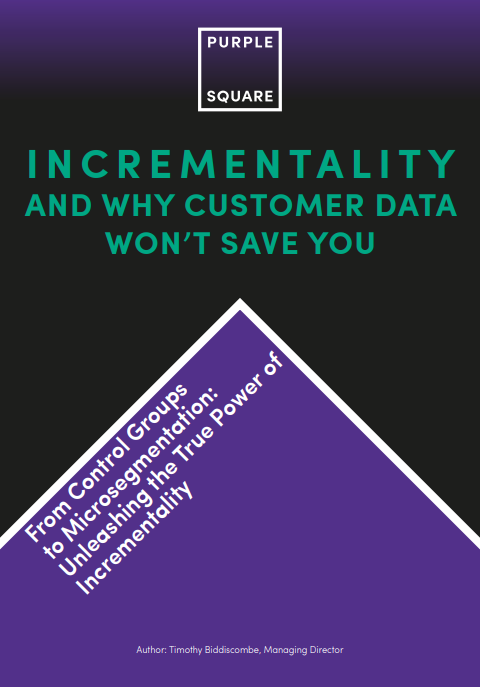Optimove on Experiencing delight: creating truly customer-driven marketing
As part of the ‘Re-imagining CX’ series, Purple Square’s Tim Biddiscombe spoke with Optimove’s Rony Vexelman about the possibilities a truly customer-first approach to marketing can unleash.
For many businesses, ‘customer-led’ marketing is anything but what it says on the tin. The most well-intentioned customer-focused campaigns and journeys are built and driven by marketers’ views and agendas about what they believe (or hope) a customer wants, rather than by the customers’ wishes themselves.
“Over the years, we’ve become accustomed as marketers to using specific journeys and following set paths of triggered actions based on common denominators derived from aggregate data,” explained Vexelman. “We need to change the way we look at CX. Wouldn’t it be delightful to create a journey that is truly different for each person?”
As marketing technology continues to evolve and AI and machine learning become more sophisticated, natural and effective, this breakaway opportunity is closer to reality than it has ever been. With the right mix of accurate data, technology, and a team of people with knowledge, insight and emotional intelligence, this vision can not only become a reality, but the benchmark by which future CX strategies can be measured.
“To make this happen, we need to look at people, not segments. We need to look at our marketing and say, ‘the way to delight my customer is not just through incentives, but to give them a journey like no other’,” Vexelman continued. “We can do this by re-thinking the way we build marketing programmes and designing them to create truly delightful experiences and moments.”
Starting with the customer: collecting first party data
Good quality, accurate data will continue to be at the core of effective customer marketing. Vexelman warns that if you don’t start by collecting up-to-date first party data from your customers and making it accessible, you are already behind the curve.
“Customer Data Platforms have been the CX buzzword for the past few years, but just collecting the data from across the organisation is not enough,” he explained. “To create truly customer-driven journeys, your marketing team needs to be able to access and make sense of it without third party intervention.”
Re-imagining CX relies on customer data and Vexelman emphasises that accessing and using the right data is the only option for success. He believes it will only get easier to use and interpret.
“We’re not far off the ability to use natural language when it comes to searching data. In the future, marketers can become data analysts,” said Vexelman. “With the right training and understanding of what information needs collecting, what to look for and how to work with it, marketers will be able to start any action or campaign from the viewpoint of individual customers.”
The people factor
A big part of true customer-driven marketing is understanding when a customer wants to interact with a human and when they are happy to use online-driven prompts and self-service. Getting the balance right varies for everyone and isn’t always intuitive.
“The human element is super important, but also [from a business perspective] super expensive,” said Vexelman. “The challenge is to provide a CX that ensures there is a person to interact with customers when they need it, but is not available every time. It is about communicating that you can help solve some of their issues digitally and actively re-direct them to a person when it’s needed.”
Traditionally to help address this delicate balance, marketers have been able to choose from a series of rigid journey options based on collective customer data from previous interactions. For example, when a customer has just returned a product, marketers have the option of offering that customer:
- an invitation to chat with a CX representative online about the process,
- a personalised email with an apology and a voucher for a future purchase,
- an appointment to talk to a live person, or
- to simply do nothing and leave them alone.
AB testing can help, but Vexelman suggests a more personalised approach:
“Use knowledge to make the right choice,” he said. “Instead of trying to force everyone down rigid pathways, why not use an algorithm based on customer DNA with the help of AI to select the best option for each customer?”
Combining technology and knowledge can help ensure that customers are presented with options tailored to their own actions and behaviours, rather than prescribed actions determined by a collective customer base.
The three levels of true personalisation
Moving from using tried and tested predetermined pathways for customer communications to true personalisation is not an easy change to make.
“Personalisation is hard,” Vexelman admitted. “It is so much more than getting an email with your name, product and location with the message marketers want you to see. You have to put the work in to get it right.”
“There are essentially three levels of personalisation,” he explained. “The first two involve personalising the message, touchpoint and the channel. Most companies do these relatively well, sending personalised text, emails or even calls triggered by prescribed journeys.”
Reaching the third level of audience personalisation, however, is much rarer.
“Most companies don’t get here. Audience personalisation is not a one size fits all approach,” continued Vexelman. “Using technologies like Optimove allows marketers to start with the customer data and use micro-segmentation and AI to personalise offers with the right message at the right time, via the right channel. They can also tailor the touchpoint itself, which means they can take the customer to exactly where they want to land.
It is this level of personalisation where the customer says ‘this brand understands me!’” he concluded.
The bottom line for success in delivering truly customer-driven marketing is not to create the experience you want your customers to go through, but to start with your customers and build the journeys they want to take. Rooting CX in knowledge about each customer means you can build something truly unique to them and deliver a customer journey like no other.
This interview was also featured in a related article on mycustomer.com on 1st August 2023. Read it here.
Like what you see?
Subscribe to our newsletter for customer experience thought leadership and marketing tips and tricks.




